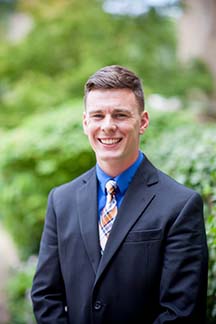 David Laston
David Laston
“It seemed like the perfect mesh,” says Laston, who joined this year’s class after about 18 months at Cummins, where he started as a lab tech and moved to research and development. “Entrepreneurship was definitely something I’d thought about – later in my life I’d like to own my own business or manage a business or startup. When I came here I wasn’t exactly sure what I was going to do. I knew it would open up a lot of career options.” David Laston, who earned a degree in chemistry from Franklin College and went to work for the giant engine manufacturer Cummins Inc. in Columbus, Ind., always knew he wanted to go back to school. When he heard about ESTEEM, he knew where to go.
Now he knows what he’s going to do. Armed with a resume retooled at ESTEEM, coaching on his cover letter, and the Go IRISH job-search website, he landed a job at Fiat/Chrysler, in a rotational corporate leadership development program of two years or more that involves working with different business units on different projects. “I thought that would be perfect for me because I didn’t know what part of the company I wanted to be part of,” he says.
Exploring options and trying new things has been a big part of Laston’s ESTEEM experience as well. His capstone thesis involves working with Trebor International, a pump supplier to the semiconductor industry, to create a “smart pump” that can use sensors and communications technology to anticipate problems with equipment and avoid downtime.
“All the classwork, I feel, is applicable to our thesis project and also any project any of us would do in the future,” he says. “One thing about ESTEEM that’s been beneficial to me is the group projects and the projects that can make an impact on the community or business.” That includes the assigned Business Model Canvas group project that tested a business idea through numerous interviews with potential users to determine viability. “Most ideas at the end weren’t viable business options, but it took us through the process of learning to determine if it is viable.”
Beyond the curriculum, Laston is on a McCloskey Business Competition team, ThermalGreen solutions, led by an MBA student, that includes four other ESTEEM students and a Notre Dame staff member. The group aims to commercialize a technology to save money and energy for owners of second homes or vacation homes as well as businesses and factories by adjusting thermostats in response to real-time temperatures rather than setting them at arbitrary fixed levels to avoid the risk of frozen water pipes.
“It’s going through the business plan, taking it a step further, interviewing people, getting feedback, financial analysis, prototype testing, getting the product to work, thinking of putting the product in people’s homes,” he says. “The biggest thing I’ve learned from the program is get out of the building and go talk to the people you think might be your target market and hopefully buy your product. If no one wants it or needs it, your business venture is going to fail right away.”
When Laston heard about the Schurz Innovation Challenge, a business plan competition focused on developing a mobile app or website around business idea, he convinced his team to join the challenge. They won a coding grant through Schurz for the South Bend Code School to develop a website for the project.
In his spare time, Laston played intramural soccer with a team of classmates last semester and basketball and soccer this semester.
He leaves ESTEEM with far more expertise and career options than a chemistry degree could offer. “I knew I wanted to be in a business that was doing engineering- or science-rleated projects of some sort,” Laston says. “I took advantage of all Notre Dame and ESTEEM provided. I think that’s going to help me wherever I go.”